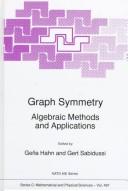| Listing 1 - 4 of 4 |
Sort by
|
Book
ISBN: 128342780X 9786613427809 0199877483 Year: 2011 Publisher: Oxford ; New York : Oxford University Press,
Abstract | Keywords | Export | Availability | Bookmark
 Loading...
Loading...Choose an application
- Reference Manager
- EndNote
- RefWorks (Direct export to RefWorks)
The theory of expander graphs is a rapidly developing topic in mathematics and computer science, with applications to communication networks, error-correcting codes, cryptography, complexity theory, and much more. Expander Families and Cayley Graphs: A Beginner's Guide is a comprehensive introduction to expander graphs, designed to act as a bridge between classroom study and active research in the field of expanders. It equips those with little or no prior knowledge with the skills necessary to both comprehend current research articles and begin their own research. Central to this book are fou
Book
ISBN: 9781470426446 1470426447 Year: 2017 Publisher: Providence, Rhode Island American Mathematical Society
Abstract | Keywords | Export | Availability | Bookmark
 Loading...
Loading...Choose an application
- Reference Manager
- EndNote
- RefWorks (Direct export to RefWorks)
We obtain a complete description of the planar cubic Cayley graphs, providing an explicit presentation and embedding for each of them. This turns out to be a rich class, comprising several infinite families. We obtain counterexamples to conjectures of Mohar, Bonnington and Watkins. Our analysis makes the involved graphs accessible to computation, corroborating a conjecture of Droms.
Dissertation
Year: 2022 Publisher: Liège Université de Liège (ULiège)
Abstract | Keywords | Export | Availability | Bookmark
 Loading...
Loading...Choose an application
- Reference Manager
- EndNote
- RefWorks (Direct export to RefWorks)
In this master's thesis, we explore the notion of growth of groups. For any finitely generated group, one can define a growth function associated to a fixed finite set of generators. It is the mapping of any positive integer n to the number of elements of a group that can be written in n generators. This allows for a classification of groups according to their growth, examples of such classes are groups of polynomial growth and groups of exponential growth. In the thesis, we define this concept with the necessary rigor. We then proceed to prove that groups of polynomial growth and virtually nilpotent groups are the same (Gromov's theorem). We also provide an example of a group, the Grigorchuk group, that has neither polynomial nor exponential growth. Dans ce mémoire, on développe la notion de croissance des groupes. Pour tout groupe finiment engendré, on définit la fonction de croissance associée à un système de générateurs finis fixé. C'est la fonction qui à un naturel n associe le nombre d'éléments du groupe qui peuvent être écrits en n générateurs. Une classification des groupes selon leur croissance est possible. On définit par exemple les groupes à croissance polynomiale ou à croissance exponentielle. Dans le mémoire, on définit ce concept avec la rigueur nécessaire. Ensuite, on prouve que les groupes virtuellement nilpotents sont à croissance polynomiale et réciproquement (théorème de Gromov). On donnera également de groupe, le groupe de Grigorchuk, qui n'est ni à croissance polynomiale ni à croissance exponentielle.
Théorie des groupes --- Théorie géométrique des groupes --- Théorème de Gromov --- Croissance des groupes --- Groupe de Grigorchuk --- Groupes nilpotents --- Graphes de Cayley --- Quasi-isométries --- Quasi-isometries --- Group theory --- Geometric group theory --- Gromov's theorem --- Growth of groups --- Grigorchuk group --- Nilpotent groups --- Cayley graphs --- Physique, chimie, mathématiques & sciences de la terre > Mathématiques

ISBN: 0792346688 9048148855 9401589372 9780792346685 Year: 1997 Volume: 497 Publisher: Dordrecht : Kluwer,
Abstract | Keywords | Export | Availability | Bookmark
 Loading...
Loading...Choose an application
- Reference Manager
- EndNote
- RefWorks (Direct export to RefWorks)
The last decade has seen two parallel developments, one in computer science, the other in mathematics, both dealing with the same kind of combinatorial structures: networks with strong symmetry properties or, in graph-theoretical language, vertex-transitive graphs, in particular their prototypical examples, Cayley graphs. In the design of large interconnection networks it was realised that many of the most fre quently used models for such networks are Cayley graphs of various well-known groups. This has spawned a considerable amount of activity in the study of the combinatorial properties of such graphs. A number of symposia and congresses (such as the bi-annual IWIN, starting in 1991) bear witness to the interest of the computer science community in this subject. On the mathematical side, and independently of any interest in applications, progress in group theory has made it possible to make a realistic attempt at a complete description of vertex-transitive graphs. The classification of the finite simple groups has played an important role in this respect.
Cayley graphs --- Group theory --- Congresses --- Discrete mathematics. --- Computer science—Mathematics. --- Group theory. --- Computer communication systems. --- Combinatorics. --- Microprocessors. --- Discrete Mathematics. --- Discrete Mathematics in Computer Science. --- Group Theory and Generalizations. --- Computer Communication Networks. --- Processor Architectures. --- Minicomputers --- Combinatorics --- Algebra --- Mathematical analysis --- Communication systems, Computer --- Computer communication systems --- Data networks, Computer --- ECNs (Electronic communication networks) --- Electronic communication networks --- Networks, Computer --- Teleprocessing networks --- Data transmission systems --- Digital communications --- Electronic systems --- Information networks --- Telecommunication --- Cyberinfrastructure --- Electronic data processing --- Network computers --- Groups, Theory of --- Substitutions (Mathematics) --- Discrete mathematical structures --- Mathematical structures, Discrete --- Structures, Discrete mathematical --- Numerical analysis --- Distributed processing --- Cayley graphs. --- Cayley color graphs --- Cayley color groups --- Cayley diagrams --- Cayley's color graphs --- Cayley's color groups --- Cayley's diagrams --- Cayley's graphs --- Color graphs, Cayley --- Color groups, Cayley --- Dehnsche Gruppenbild --- Diagrams, Cayley --- Gruppenbild, Dehnsche --- Graph theory --- Graphes, Théorie des
| Listing 1 - 4 of 4 |
Sort by
|

 Search
Search Feedback
Feedback About UniCat
About UniCat  Help
Help News
News